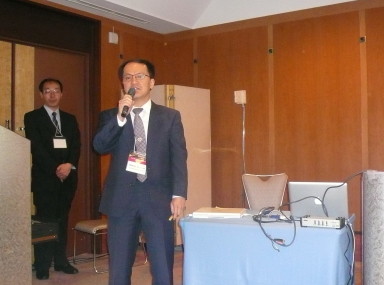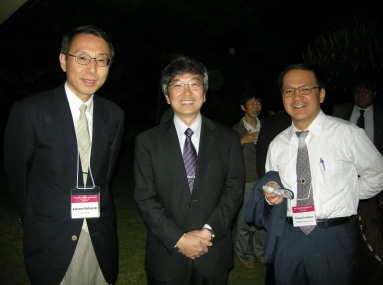
第12回日独ペプチドシンポジウム
New Tag-probe Systems for Specific Detection of Target Proteins.
玉村 啓和、堤 浩
場所:京都
日時:2008年5月16-17日

The detail analysis of functions and behavior of proteins in living cells has been important in the proteome era. Fluorescent bio-imaging of proteins has been one of the most useful techniques in chemical biology. A tag-probe system is a helpful imaging tool, which can label target proteins by fluorescent probes that bind specifically to tag peptides genetically incorporated into the proteins . However, a step of washing excess free probes is required for selective detection of target proteins in the use of tag-probe pairs since free probes also have fluorescent activity similar to the tag-bound probes. The binding of the probe to a target protein via its complement tag with remarkable fluorescent change (wavelength shift and/or increase in fluorescent intensity) might enable us to distinguish the labeled protein from a free probe. Herein, three a-helical antiparallel leucine zipper peptides were adopted for the development of fluorescent changeable tag-probe pairs. A probe peptide is designed as one a-helical peptide that has 4-nitrobenzo-2-oxa-1,3-diazole (NBD), which belongs to an environmental sensitive fluorescent dye. Tag peptides are designed as two a-helical antiparallel peptides. The amino acids that are located on the complementary position against NBD of the probe peptide are replaced by alanines. The fluorescent titration of the probe peptide into tag peptides showed not only a remarkable wavelength shift from 536 nm to 505 nm, but also approximate 18-fold increase in fluorescent intensity at 505 nm based on formation of the tag-probe complex. The dissociation constant between the probe and tag peptides is 17.5 nM. CD analysis showed that the probe and tag peptide form a stable three a-helical bundle structure. Thus, the present tag-probe pair involving three a-helical antiparallel leucine zipper peptides will be a useful tool for sensing biology, such as fluorescent imaging of proteins.

左:京大 松崎教授、中央:北大 坂口教授 右:玉村教授